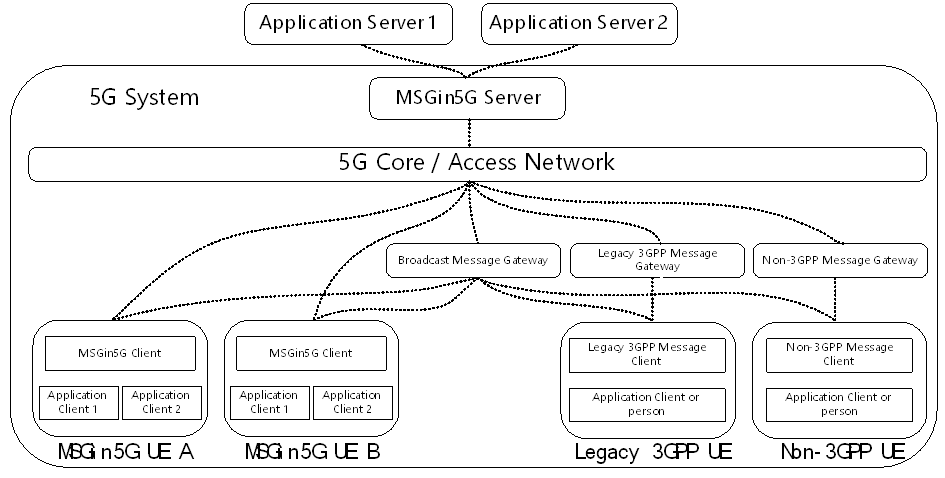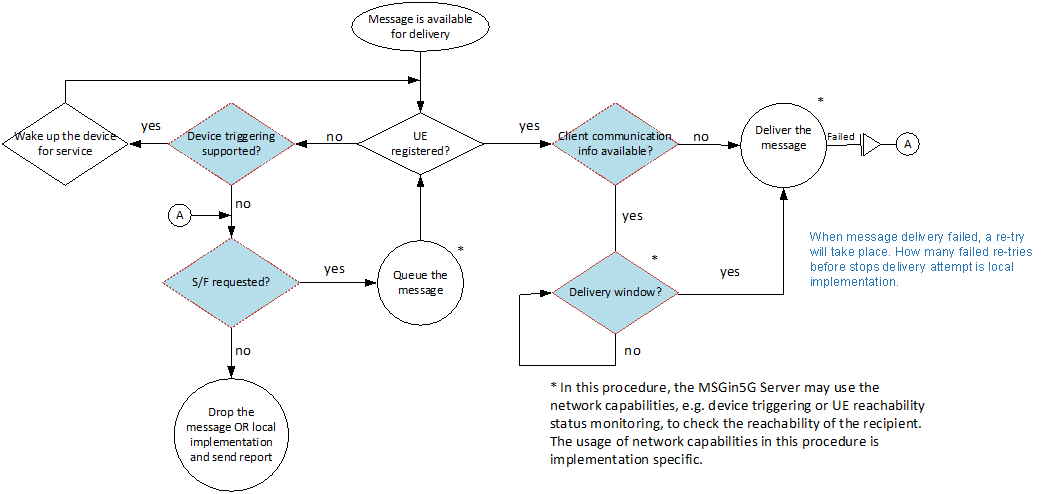Content for TS 23.554 Word version: 19.1.0
7 Generic description of the MSGin5G Service (informative)
7.1 General
7.2 Service flow
7.3 Message delivery flow at MSGin5G Server
...
...
7 Generic description of the MSGin5G Service (informative) p. 26
7.1 General p. 26
Massive Internet of Things (MIoT) is one of key market segments of 5G. The typical IoT device communication is sending and receiving small data which can be delivered just in a message. The MSGin5G Service is designed and optimized for massive IoT device communication including thing-to-thing communication and person-to-thing communication.
The MSGin5G Service is a message enabler for applications. An Application Client in a UE utilizes MSGin5G Service to send a message to another UE, to multiple UEs or to the Application Server, or the Application Server utilizes the MSGin5G Service to send a message to a UE or to multiple UEs. All messages will be routed via the MSGin5G Server in the 5G system. The MSGin5G Service flow is shown in Figure 7.1-1.
If the UE supports a legacy 3GPP message service (e.g. SMS, NIDD, or CB) and does not support the MSGin5G Service (i.e. UE has no MSGin5G Client), the message will be translated to the appropriate message delivery mechanism by the Legacy 3GPP Message Gateway. A UE that does not support any 3GPP message service can connect to the MSGin5G Service via Non-3GPP Message Gateway that facilitates the translation between the MSGin5G Service and non-3GPP message delivery mechanism. The connection between such UE and the gateway can be via 3GPP access or non 3GPP access (e.g. WLAN) and is out of scope of the present specification.
An Application Server resides outside the 3GPP domain and connects to the MSGin5G Server via a CAPIF-aware reference point.
The message communication models include:
- Point-to-Point messaging: message that is originated at a UE (UE A) and terminated at another UE (UE B, a Legacy 3GPP UE or a Non-3GPP UE).
- AS-to-Point messaging: message that is originated at an Application Sever and terminated at a UE.
- Point-to-AS messaging: message that is originated at a UE and terminated at an Application Sever.
- Group Messaging: message that is originated at a UE or an Application Server and is terminated at a group of UEs (a group member can be of type UE A, Legacy 3GPP UE or Non-3GPP UE).
- Broadcast Messaging: message that is originated at an Application Sever or an MSGin5G UE and broadcasted to all the UEs in a specific Broadcast Area within coverage of a cell or of multiple cells. An existing broadcast function (e.g. CB specified in TS 23.041) may be reused in broadcast messaging of MSGin5G Service.
- Topic Messaging: message that is originated at an Application Sever or a UE and is delivered to all UEs and Application Server(s) that have subscribed to the topic.

7.2 Service flow p. 27
Before a UE or an Application Server can use the MSGin5G Service it needs to register with the MSGin5G Server.
A UE registers with its identity, its security credentials, the capabilities that it supports, and its availability. The MSGin5G Server will use the availability registration and de-registration to determine if the UE is available for message delivery. If a UE is unavailable for message delivery, the MSGin5G Server will store the message and deliver it once the UE becomes available again.
When a UE or an Application Server sends an MSGin5G message to a recipient UE then such message will be sent to the MSGin5G Server and this server will deliver the message to the UE based on the capabilities of the recipient UE (MSGin5G UE, Legacy 3GPP UE or Non-3GPP UE). If the recipient UE is a Legacy 3GPP UE then the MSGin5G Server will forward the message to the Legacy 3GPP Message Gateway and this gateway will convert the message to a message that is supported by the recipient UE (e.g. SMS, NIDD or CB). If the recipient UE is a Non-3GPP UE then the MSGin5G Server will forward the message to the Non-3GPP Message Gateway and this gateway will convert the message to a message that is supported by the recipient UE.
A Legacy 3GPP UE sends the application payload to the Legacy 3GPP Message Gateway and this gateway will forward the application payload in an MSGin5G message to the MSGin5G Server, which will deliver the message to the recipient UE(s). A Non-3GPP UE sends the application payload to the Non-3GPP Message Gateway and this gateway will forward the application payload in an MSGin5G message to the MSGin5G Server, which will deliver the message to the recipient UE(s).
If a UE or an Application Server sends an MSGin5G message to a group of UEs, the MSGin5G Server will deliver the message to all group members taking into account if such a UE is an MSGin5G UE, a Legacy 3GPP UE or a Non-MSGin5G UE and if such UE is available for delivery.
If a UE or an Application Server sends an MSGin5G message containing a Messaging Topic to the MSGin5G Server, the MSGin5G Server will distribute the message to all UEs and Application Servers that have subscribed to that topic.
If a UE or an Application Server sends a broadcast message to a Broadcast Area, the MSGin5G Server forwards the message to the Broadcast Message Gateway and this gateway will forward the message to the broadcast function.
An originating UE or Application Server may request the recipient UE(s) to acknowledge reception of the message. If such a request is made, a message delivery status report shall be sent by the recipient MSGin5G UE or the Message Gateway (on behalf of the Non-MSGin5G UE) as a point-to-point message back to the originating UE or Application Server. The acknolwedgement information is included in the payload and the format of this information is out of scope of the present specification.
The Non-MSGin5G UE may respond to an incoming MSGin5G message; it is subject to the Message Gateway implementation to maintain the transaction of the incoming MSGin5G message and reply to it to the sender, with the response it receives from the Non-MSGin5G UE.
7.3 Message delivery flow at MSGin5G Server |R18| p. 28
Figure 7.3-1 shows the flow for message delivery by the MSGin5G Server.
